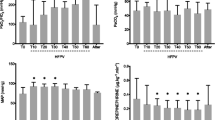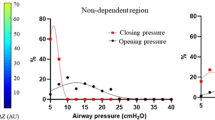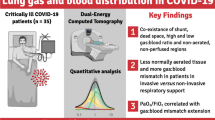Abstract
Objective: To determine whether differences in lung morphology assessed by computed tomography (CT) affect the response to positive end-expiratory pressure (PEEP).¶Design: Prospective study over a 53-month period.¶Setting: Fourteen-bed surgical intensive care unit of a university hospital.¶Patients and participants: Seventy-one consecutive patients with early adult respiratory distress syndrome (ARDS).¶Measurements and results: Fast spiral thoracic CT was performed at zero end-expiratory pressure (ZEEP) and after implementation of PEEP 10 cmH2O. Hemodynamic and respiratory parameters were measured in both conditions. PEEP-induced overdistension and alveolar recruitment were quantified by specifically designed software (Lungview). Overdistension occurred only in the upper lobes and was significantly correlated with the volume of lung, characterized by a CT attenuation ranging between –900 and –800 HU in ZEEP conditions. Cardiorespiratory effects of PEEP were similar in patients with primary and secondary ARDS. PEEP-induced alveolar recruitment of the lower lobes was significantly correlated with their lung volume (gas + tissue) at functional residual capacity. PEEP-induced alveolar recruitment was greater in the lower lobes with “inflammatory atelectasis” than in the lower lobes with “mechanical atelectasis.” Lung morphology as assessed by CT markedly influenced the effects of PEEP: in patients with diffuse CT attenuations PEEP induced a marked alveolar recruitment without overdistension, whereas in patients with lobar CT attenuations PEEP induced a mild alveolar recruitment associated with overdistension of previously aerated lung areas. These results can be explained by the uneven distribution of regional compliance characterizing patients with lobar CT attenuations (compliant upper lobes and stiff lower lobes) contrasting with a more even distribution of regional compliances observed in patients with diffuse CT attenuations.¶Conclusions: In patients with ARDS, the cardiorespiratory effects of PEEP are affected by lung morphology rather than by the cause of the lung injury (primary versus secondary ARDS). The regional distribution of the loss of aeration and the type of atelectasis –“mechanical” with a massive loss of lung volume, or “inflammatory” with a preservation of lung volume – characterizing the lower lobes are the main determinants of the cardiorespiratory effects of PEEP.
Similar content being viewed by others
Author information
Authors and Affiliations
Additional information
Received: 13 July 1999/Final revision received: 9 February 2000/Accepted: 10 April 2000
Rights and permissions
About this article
Cite this article
Puybasset, L., Gusman, P., Muller, JC. et al. Regional distribution of gas and tissue in acute respiratory distress syndrome. III. Consequences for the effects of positive end-expiratory pressure. Intensive Care Med 26, 1215–1227 (2000). https://doi.org/10.1007/s001340051340
Published:
Issue Date:
DOI: https://doi.org/10.1007/s001340051340




